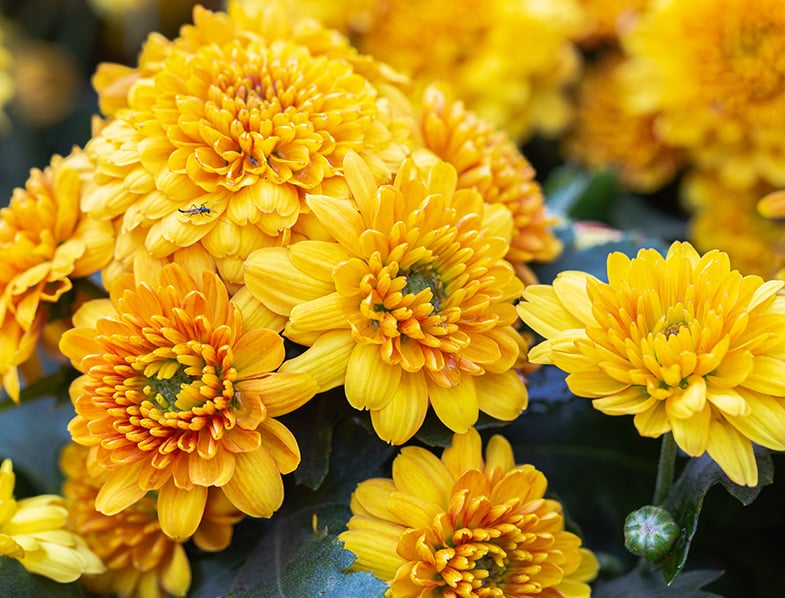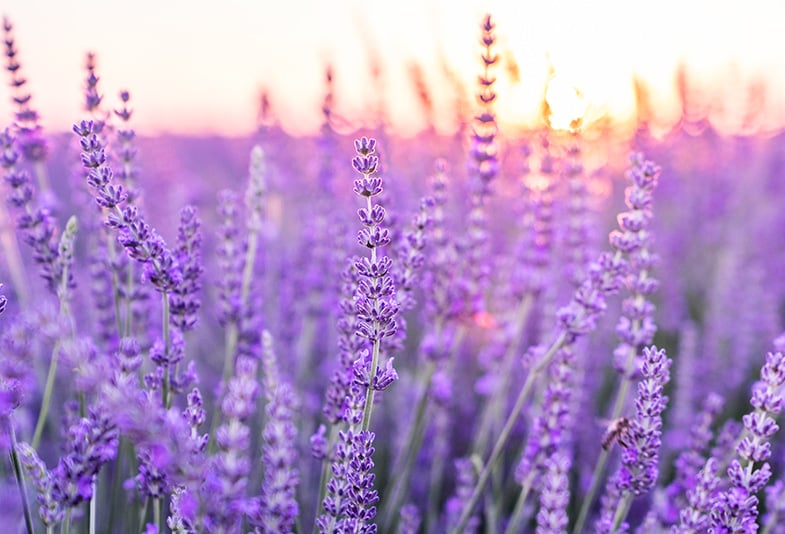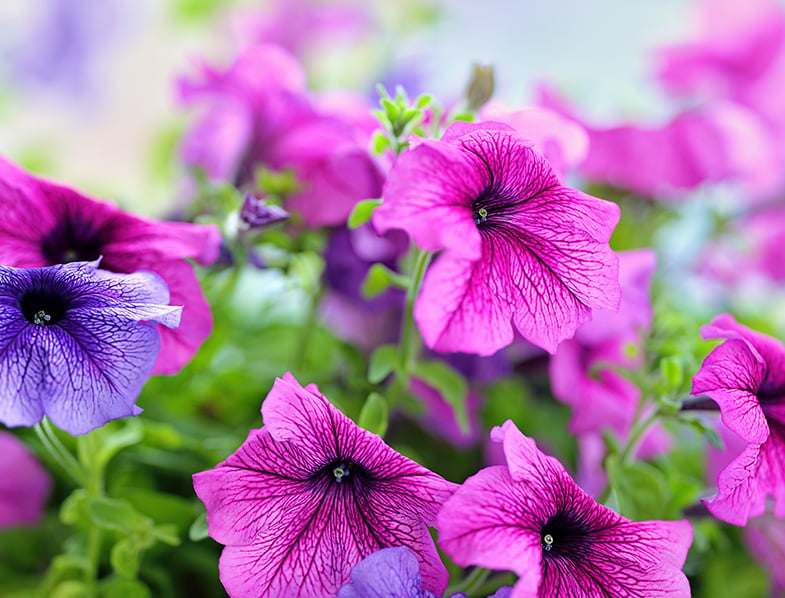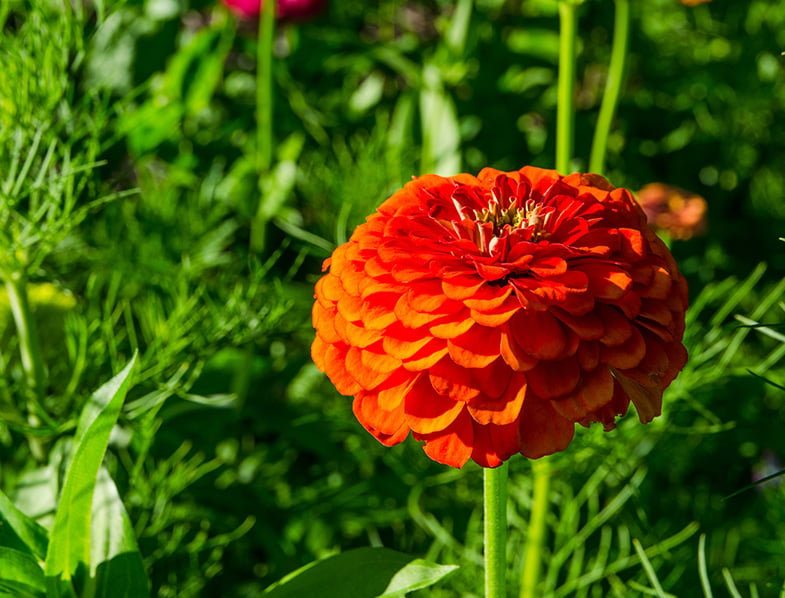Every gardener knows that a garden is more than just a beautiful sight. It is a rich ecosystem where everything is connected and the garden thrives when this ecosystem is balanced. While all creatures serve a purpose on earth, certain creatures are not welcomed in a garden. We are talking about pests that can damage your garden and ruin a healthy garden environment.
Most people think that pests are inevitable from time to time but this isn’t always the case. There are certain plants that most pests don’t like and some of these plants can even repel most insects.
Now, everybody knows that aromatic herbs repel pests, but we are not going to talk about herbs in this article. Instead, we’ll talk about gorgeous flowering plants that will beautify your garden without attracting any pests.
Keep on reading to discover the most beautiful plants which repel bugs and other insects.
Watch Our Latest YouTube Video ...
1. Chrysanthemums
The Chrysanthemum belongs to the Asteraceae family. Its average height ranges between 40 and 100 cm. Being quite tall, it is suitable for the middle of the last row of flower displays. Depending on its variety, the Mum can act either as an annual or a perennial. It blooms from June to November and its flowers come in a multitude of colours from yellow, to white, orange, pink, red, lavender or purple.
Chrysanthemums have rich foliage which gives them a bushy appearance, but it is their flowers that make them truly special. Their stems are strong and each stem can hold several blooms. But the best thing about Mums is their ability to repel pests. They contain Pyrethrum, a substance that is frequently used in insect repellents.

Caring for Chrysanthemums is not difficult. They can survive in almost any soil, and they look best when planted in areas where they get full sun exposure. You can grow them from seed, but it can be time-consuming. Most people buy them in pots and replant them directly on the ground.
Once you have several mature plants in your garden, you can propagate them through crown division in the spring. Plant as many as possible. These plants don’t mind being crowded and they look best when planted in masses. Chrysanthemums repel numerous insects like roaches, ants, ticks, lice, fleas, spider mites, and much more. To learn more about growing and caring for these amazing flowers, check out our complete Chrysanthemums guide.
2. Lavender
The scent of lavender is known to reduce stress and induce relaxation but there is much more to lavender than just a relaxing scent. Lavender oil makes for an amazing insect repellent. Extracts are more potent, but the natural scent of this plant also does a great job repelling moths, flies, mosquitoes, and many other insects.
It’s also great at keeping deer and other munchers at bays. Munchers prefer the edges of gardens because they don’t like getting too close to buildings. So, for the best effect, try to plant lavender on the outside edges of your garden.

Growing and caring for lavender is quite easy, especially if you grow it from cuttings. Growing from seed is slightly more challenging, so it is best to start with cuttings. Lavender needs well-drained soil and full sun exposure. Enriching the soil with organic matter is also a great way to improve your chances of growing lavender.
Other than that, once you plant the lavender, you can forget about it. It doesn’t need fertilizing and in a moderate climate, it can do a great job gathering moisture from the soil. If the soil gets too dry, feel free to water it from time to time. Deep, infrequent watering sessions are ideal. As far as pruning goes, cut back the plants each year after blooming.
3. Nasturtiums
While many plants can repel mosquitoes and munchers, few can repel plant pests like aphids or whiteflies. This is where Nasturtiums come to the rescue. Due to their pest-resistant properties, they are among the best companion plants. Their beautiful flowers make them ideal for flower beds.
Due to their pest-resistant properties, Nasturtiums are also frequently planted in vegetable gardens. They can reach a top height of 30 cm and a top spread of 50 cm. They make for excellent ground covers, but can also be planted in containers. Their flowers are funnel-shaped and come in shades of yellow, orange, and red.

Nasturtiums are annual plants but they are excellent self-seeders so they will come back year after year. They can survive in partial shade, but they need full sun exposure to grow the masses of flowers that everybody loves.
They grow best in poor, well-drained soil. If the soil is too rich in nutrients, the plant will focus more on foliage growth and less on blooming. While they are hardy plants, nasturtiums need to be watered regularly, especially when the plants are young. These plants are also very easy to grow, and you can sow the seeds directly outdoors.
4. Marigolds
Marigolds are among those miracle plants that repel pests yet attract beneficial pollinators.
They repel whiteflies, aphids, and different types of nematodes like cabbage worms. Marigolds are annuals and can be grown almost all over the world.
Depending on the variety, the height of marigolds ranges between 30 cm and 1 meter, and their spread can range between 15 to 60 cm. They have bushy foliage and they bloom in clusters. They look best when planted in masses. Their flowers come in a wide variety of colours from bright yellow, to deep orange, red, and gold. The flowers can feature single colour or two colours in ombre or stripe patterns.

It’s recommended planting your Marigolds early in spring, after the last frost. They like full sun exposure but might need some dappled shade during extremely hot afternoons. They also need some protection from strong winds and heavy rainfalls.
The good thing about these plants is that they are quick germinators, so they can easily be grown from seed. Pruning is necessary and it depends on how you want the plants to look. Deadhead them to encourage further blooming and pinch them to encourage a bushier look.
5. Petunias
Petunias are among the most beautiful cascading flowers and it is best to plant them in containers. They can be a little sensitive to environmental factors, so containers allow you to place the flowers in the sunniest locations and to move them when you need to shelter them from heavy winds or rain.
These annuals bloom from spring until frost and they have a lovely fragrance. Unlike other pest repelling plants, the petunia-s weapon against pests is not their odour. They have sticky hairs that trap the insects. Once the insects are dead, they are used as nutrients that are absorbed through the roots.

Even though most people think they are annuals, petunias can actually survive as perennials in certain areas, like USDA zones 9 to 11. They bloom from spring until frost. Their abundance of bloom comes in many colours like white, red, salmon, pink, lavender, yellow, purple, and bicolors.
Growing Petunias from seeds can be a tad time-consuming, so it is best to buy young plants. They enjoy regular watering, once or twice per week, depending on the weather. Towards the middle of the summer, they tend to get a little leggy. Keep them in check by pruning the shoots back. To learn more about growing and caring for these lovely plants, read our complete Petunia guide.
6. Zinnias
Zinnias don’t repel mosquitoes or plant-eating insects, but they do repel deer. The prickly centres of the flowers are very unpleasant for deer. As such you can use these flowers as a living fence to keep deer away from your garden.
These plants will also beautify your garden as their colourful flowers are quite an eye-catcher. Their bloom from late spring until the first frost. Their flowers come in deep shades of pink, red, yellow, purple, lavender, orange, and white. They come in different varieties which differentiate themselves by the number of petal rows.

Zinnias don’t like to be transplanted, so it is best to grow them from seed in garden beds. Since they are sensitive to frost, you must sow the seeds once the danger of the last frost has passed. Zinnias are sun-loving plants so make sure to choose a good location for them. They are adaptable to any soil, especially if it is enriched with compost. They are fast germination, so you should see seedlings in about a week.
As far as maintenance goes, keep the soil moderately moist and deadhead when needed. Find out more about these beautiful plants from our Zinnia Elegans Guide.
7. Bloody Cranesbill
This is another plant that attracts pollinators but repels annoying insects, as well as munchers like deer and rabbits. It is often confused with the annual Pelargonium, but the Bloody Cranesbill is actually the true perennial geranium. It blooms from late spring to late summer and it features pink flowers and dark green leaves. Its name comes not from its flower, but from its palmated lobed leaves which turn from green to a bloody red during the fall.

Geranium Sanguineum can reach a top height of 30 cm and a top spread of 50 cm. This bushy-looking perennial can thrive in both full sun and partial shade. It is great for borders and flower bests. Like most bushy plants, Bloody Crane’s Bill looks best in massed plantings. It requires little to no maintenance.
Occasional deadheading and pinching off old leaves will encourage new blooms and foliage growth. It likes well-drained soil and can adjust to most weather conditions, even drought and high humidity. You can propagate it through seeds, stem cuttings, semi-ride cuttings, or root division. It’s best to take the cuttings in summer, but the best time for root is in autumn or spring.
8. Butter Daisy
Melampodium or the Butter Daisy is an annual that will add some sunshine to your garden, while also keeping deer and mosquitoes at bay. It is native to Central and South America and it can be grown in USDA areas 6-9. In fact, it can be grown as a perennial in area 9. It can reach a top height of 40 cm and a top spread of 30 cm. It is great for beds and borders and it is a good companion plant.
It’s best to plant Butter Daisies in a sunny location in well-drained soil. To encourage rich blooms, use a balanced liquid fertilizer once a month. Keep the soil evenly moist and water it frequently in dry weather. You can plant these flowers anytime from spring until fall.

If they get enough sunshine and water, your Butter Daisies will spread quickly. It helps if you add some organic matter to your soil before planting the daisies. Manure, compost, and peat most are great for loosening the soil, improving drainage, and enriching the soil. A richer soil will also encourage the appearance of earthworms and other beneficial organisms.
Deadheading will also benefit the plant and after the blooming season, you can remove the entire stalks of the spent flowers. This keeps the plant focused on growth.
In Conclusion
Pests come in all shapes and sizes. An unhealthy garden that lacks diversity can quickly develop aphids, whiteflies, or leaf miners. Deer, rabbits, and other munchers can also be a problem, especially if you live in a wilder environment.
There are also insects like mosquitoes which are not a problem for the plants, but they make it more uncomfortable for you to spend time in the garden. All of these pests can be repelled and avoided if you plant the right type of plants in your garden.
The more diverse a garden is, the easier it will be to develop a healthy ecosystem. A healthy environment attracts beneficial insects and organisms and repels most types of pests. The good news is that most pest-repelling plants are also beautiful and low maintenance.
The plants presented above have similar growing needs. They are sun-loving plants that thrive in well-drained soil. They differ in size and bloom colours, so you can combine them according to your needs and the design of your garden. These plants will be great prevention against pests but you must continue to keep a close eye on your plants.
Monitoring them will allow you to catch the early signs of pests and take measures to prevent serious garden damage.
Are you growing other plants that keep pests at bay? Let us know in the comments!
